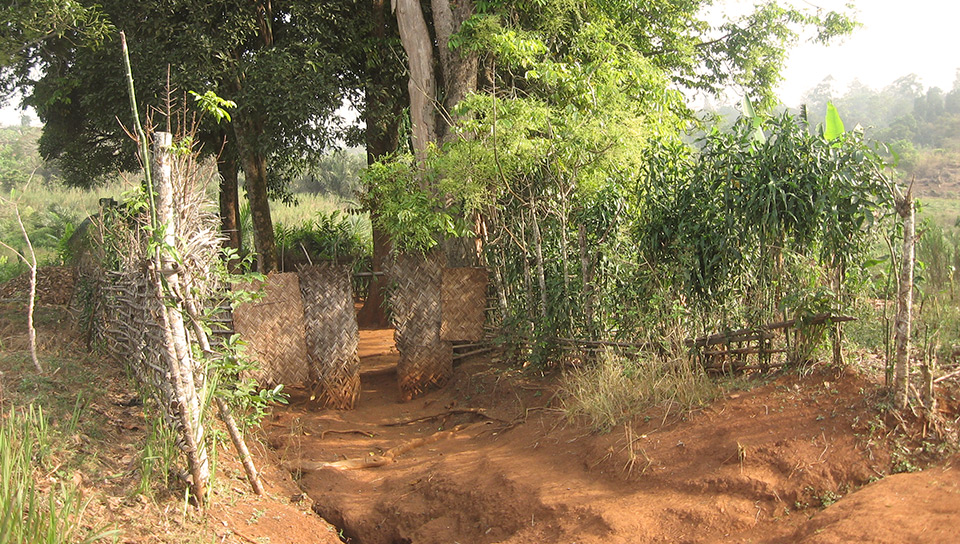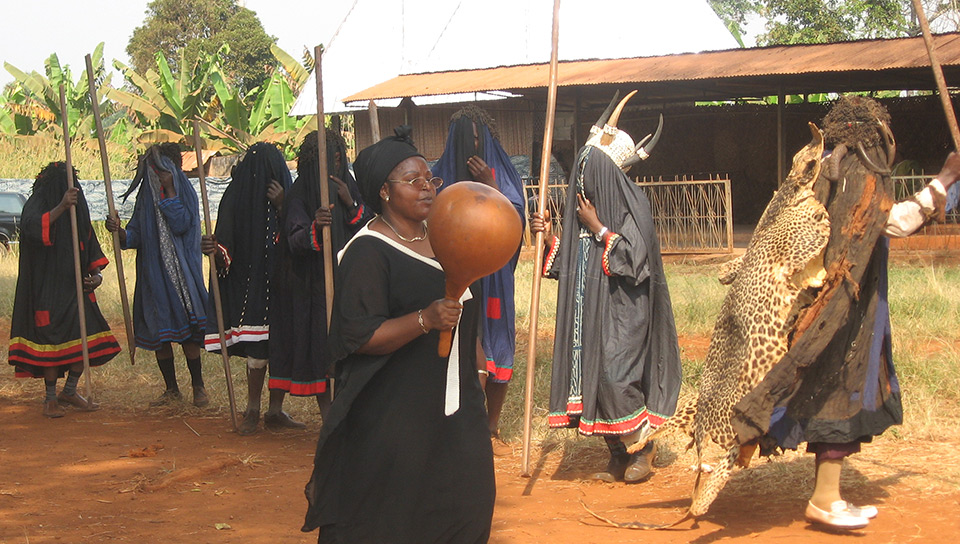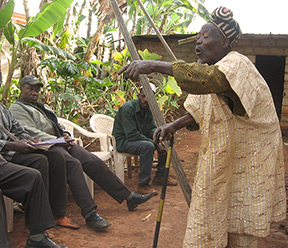בשטח Bandjoun במערב של קמרון לשקר אתרים שונים נתפסים כקדוש על ידי האנשים המקומיים. הם ליבות השרידים של אתרים שהיו היסטוריים הרבה יותר נרחבים המייצגים את זהותם של שבטים וקהילות באזור. אופי האתרים הנפרדים שונה מבחינת התפקוד והקבוצה החברתית שעושה שימוש בה. שתי דוגמאות הן מקדשים משפחתיים, בדרך כלל עם נוכחות של עץ תאנה (FICUS SP.), ומקומות איסוף קהילתיים המהווים מרכזים של יוזמות מסורתיות לחיי הקהילה. התפקוד המשותף של רוב האתרים הוא פולחן של האלים. למרות שהאקולוגיה של אתרי טבע הקדושים אלה זכתה לתשומת לב מועטת עד כה, הם ידועים לבעלי חיים וצמחי נמל שנעלמו במידה רבה מהסביבה.
איומים
מנהיגים מסורתיים הצהירו כי הישרדותם של אזורים קדושים אינה מאוימת מכיוון שאזורים אלה קשורים מאוד לזהות הקהילה. אף על פי כן הם דואגים מהיחס המשתנה של צעירים שהופכים לחומרניסטיים יותר ויותר ומלאים טאבו ויראו שמא כבוד לאמונות אבות. היום, אנשים רבים משתמשים באזורים קדושים מבלי ליידע את האפוטרופוס שלהם, המציין את השחיקה בנורמות תרבותיות. איומים מרכזיים יותר זוהו, עדיין הם הכי תחת ויכוח בין האנשים המקומיים את עצמם.
פיתוח תשתיות, במיוחד בניית דרכים והתיישבות עירונית, גרם להשפלת אזורים קדושים ב- Bandjoun. הרחבת הנצרות מציעה השקפות אלטרנטיביות על הצורך בהגנה וכנות. אומרים כי כמה כוהנים נוצריים בעלי השקפה דיבולית באתרים הקדושים. לדברי כמה מנהיגים רוחניים מסורתיים מקומיים, העובדה שעונשו של כריסטיאן על מעשים לא נכונים מגיע לאחר המוות, בעוד שאמונות מקומיות עונש נוטל השפעה מיידית מגביר את חוסר ציותם של אנשים באמונות האבות והטאבו.
אולם, דווח גם על השפעה יורדת של הנצרות על אמונות מקומיות כמו גם נכונות הולכת וגוברת של הכמרים הנוצרים להאזין למקומיים ולעבוד על הבנה בין -דתית. לדברי חלק, אפילו לחינוך מודרני יכולה להיות השפעה שלילית על האמונות המסורתיות, בגלל הזמן היורד שהילדים מבלים עם הוריהם. בנוסף, אורח החיים המשתנה גורם לירידה בהתעניינות בערכים המסורתיים שמביאים את המשך הטיפול באתרי הטבע הקדושים הללו בסיכון.
נאמנים
במשך מאות השנים, אנשי Bandjoun פיתחו מערכת ניהול של אב קדמון של אתרי טבע קדושים. המיקום של אתרים מקודשים טבעיים וטבעיים למחצה מזוהה על ידי המנהיגים הרוחניים יזמו (MkamSi, שִׂיא). בעוד שרוב היו ותיק, מיקומו של אזור קדוש אינו בלתי ניתן לשינוי וניתן לשנותו מסיבות כמו בניית כבישים או כיוון מחדש סוציו-פוליטי. בדרך כלל, כל אזור קדוש מגיע תחת אחריותו של אפוטרופוס בשם Nongtchuép. הוא אחראי על ביצוע הנפקות וקורבנות, שעבורו הוא גם יכול לחייב נציג. אלה זקנים יוזמים שהם משמרים אוניברסליים. יש להם את הזכות לעבוד בכל אתרי הפולחן.
למרות שנשים נחשבות בדרך כלל כמתאימות לאזורים קדושים, מחקירה עמוקה יותר העלתה כי תפקידם קיים, אבל מוסתר ומתעלם. למשל, מגנסי (נְקֵבָה שווה ערך ל MkamSi) יש את אותם יכולות וחובות כמו עמיתיהם הגברים. רק האמהות של התאומים היזומים יכולים לנקות אתרים קדושים מסוימים. אישה יכולה להחליף את ראש המשפחה ולקבוע מנחות והקרבנות במקום קדוש. יתר על כן, החינוך המסורתי ניתן בעיקר על ידי נשים האוכפות תקנות שימור לאזורים קדושים.
שימור הגדרות
הכלים הבאים לשימור שהוקמו עד כה:
- רשימה של צעדים שינקטו הבא
- רשימה של בעלי עניין
- הצהרות של המנהיגים המסורתיים
- מחקרים חברתיים המכילים את חזונו של העם המקומי על המצב
- מפות שיתופיות של אתרי הטבע הקדושים באזור
חזון
ההתקדמות הגדולה ביותר התומכת בשימור של אזורים מקודשים תהיה ההכרה המשפטית שלהם, מודעות ציבוריים גדלו, שינויים שליליים מופחתים בשימוש בקרקע ובהכרה טובה יותר של חשיבותו החברתית תרבותית והאקולוגית שלהם. על מנת להשיג את כל האמור לעיל יחייב מעורבות של בעלי העניין ברמה מקומית, רמות לאומיות ובינלאומיות.
קואליציה
יש צורך בתמיכה יעילה ומתאימה לשימור נוסף של אתרים אלה. כפתרון אפשרי, חברי קהילת Bandjoun מציעים למעורבות בעלי עניין כמו נשים, צעירים, ארגונים לא ממשלתיים, מוסדות דתיים ואולי אפילו מוסדות מדינה לפתח ניהול באזורים קדושים באופן משתתף תוך הסכמה בבירור על תפקידו של כל בעל עניין.
פעולה
ליטל פעולה נעשית כיום, מלבד כמה מחקרים להעלות את המודעות של אנשים שBandjoun האתרים הקדושים שלהם נמצאים על כף מאזניים. Banjoun דורש תמיכה כדי לזהות אתרי טבע מקודש בסכנת הכחדה חשוב לקהילות. הם רוצים להפוך את תיחום ברור שלהם ולפתח אסטרטגיה מתאימה לניהול בר הקיימא שלהם.
מדיניות ומשפט
את אתרי הטבע המקודשים בתחום זה כיום אינם מוכרים באופן חוקי. ניהול יער בסך הכל הוא החשש של משרד יערות וחיות בר על פי פסלים משפטיים קמרון.
כתוצאה ממחקר חברתי, עלייה במודעות של עם Bandjoun הן ההישג החשוב ביותר עד כה. זוהי השקפה מרוויחה כי מעורבותה של המדינה בניהול אתרי טבע קדושים יכולה להוות סיכון וליצור סכסוך. פקידי ממשלה חשודים לרוצים משאבים המתאימים, כוונה להחליש את כוחם של הזקנים. חברי הקהילה מציעים להעלות את המודעות ציבוריות, מיפוי וסימון הגבולות של האזורים המקודשים, שיפור ידע, בעלי עניין העובדים יחד ופתח כוח של הממשלה עשויים להיות פתרונות טובים להפסיק את המצב המחמיר.
- Kamga-Kamdamm S L., (2010) אמונות ושימור אבות. The case of sacred natural sites in Banjoun, מערב קמרון, בVerschuuren, ב ', Wild ר ', מקנילי, J. ואוביידו., סול. (עורכים.) אתרי הטבע הקדוש, תרבות שימור הטבע, כדור הארץ סריקה, לונדון,.PP. 119-128.






